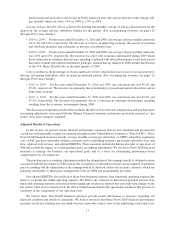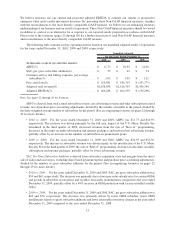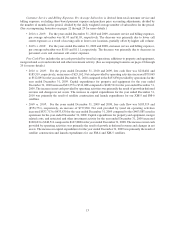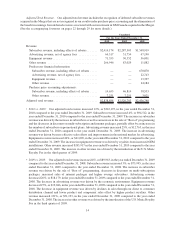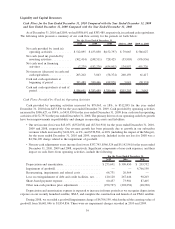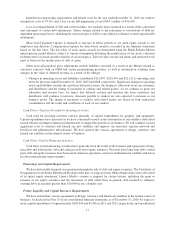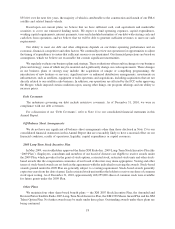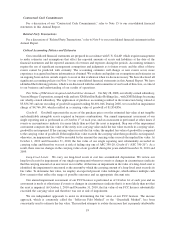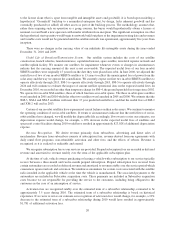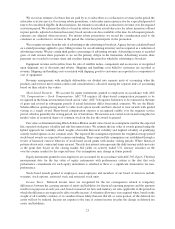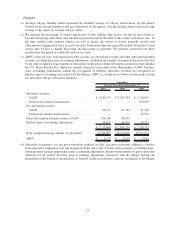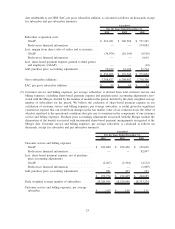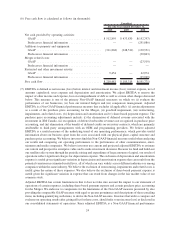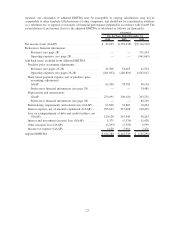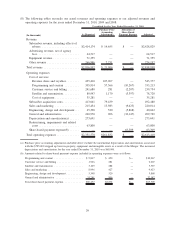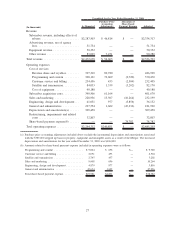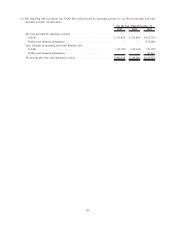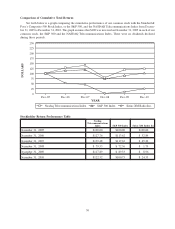XM Radio 2010 Annual Report Download - page 77
Download and view the complete annual report
Please find page 77 of the 2010 XM Radio annual report below. You can navigate through the pages in the report by either clicking on the pages listed below, or by using the keyword search tool below to find specific information within the annual report.We record an estimate of rebates that are paid by us to subscribers as a reduction to revenue in the period the
subscriber activates service. For certain rebate promotions, a subscriber must remain active for a specified period of
time to be considered eligible. In those instances, the estimate is recorded as a reduction to revenue over the required
activation period. We estimate the effects of mail-in rebates based on actual take-rates for rebate incentives offered
in prior periods, adjusted as deemed necessary based on take-rate data available at the time. In subsequent periods,
estimates are adjusted when necessary. For instant rebate promotions, we record the consideration paid to the
consumer as a reduction to revenue in the period the customer participates in the promotion.
We recognize revenue from the sale of advertising as the advertising is broadcast. Agency fees are calculated based
on a stated percentage applied to gross billing revenue for our advertising inventory and are reported as a reduction of
advertising revenue. We pay certain third parties a percentage of advertising revenue. Advertising revenue is recorded
gross of such revenue share payments as we are the primary obligor in the transaction. Advertising revenue share
payments are recorded to revenue share and royalties during the period in which the advertising is broadcast.
Equipment revenue and royalties from the sale of satellite radios, components and accessories is recognized
upon shipment, net of discounts and rebates. Shipping and handling costs billed to customers are recorded as
revenue. Shipping and handling costs associated with shipping goods to customers are reported as a component of
cost of equipment.
Revenue arrangements with multiple deliverables are divided into separate units of accounting when the
products and services meet certain criteria and consideration is allocated among the separate units of accounting
based on their relative fair values.
Share-based Payment. We account for equity instruments granted to employees in accordance with ASC
718, Compensation — Stock Compensation. ASC 718 requires all share-based compensation payments to be
recognized in the financial statements based on fair value. ASC 718 requires forfeitures to be estimated at the time
of grant and revised in subsequent periods if actual forfeitures differ from initial estimates. We use the Black-
Scholes-Merton option-pricing model to value stock option awards and have elected to treat awards with graded
vesting as a single award. Share-based compensation expense is recognized ratably over the requisite service
period, which is generally the vesting period, net of forfeitures. We measure non-vested stock awards using the fair
market value of restricted shares of common stock on the day the award is granted.
Fair value as determined using Black-Scholes-Merton model varies based on assumptions used for the expected
life, expected stock price volatility and risk-free interest rates. We estimate the fair value of awards granted using the
hybrid approach for volatility, which weights observable historical volatility and implied volatility of qualifying
actively traded options on our common stock. The expected life assumption represents the weighted-average period
stock-based awards are expected to remain outstanding. These expected life assumptions are established through a
review of historical exercise behavior of stock-based award grants with similar vesting periods. Where historical
patterns do not exist, contractual terms are used. The risk-free interest rate represents the daily treasury yield curve rate
at the grant date based on the closing market bid yields on actively traded U.S. treasury securities in the
over-the-counter market for the expected term. Our assumptions may change in future periods.
Equity instruments granted to non-employees are accounted for in accordance with ASC 505, Equity. The final
measurement date for the fair value of equity instruments with performance criteria is the date that each
performance commitment for such equity instrument is satisfied or there is a significant disincentive for non-
performance.
Stock-based awards granted to employees, non-employees and members of our board of directors include
warrants, stock options, restricted stock and restricted stock units.
Income Taxes. Deferred income taxes are recognized for the tax consequences related to temporary
differences between the carrying amount of assets and liabilities for financial reporting purposes and the amounts
used for tax purposes at each year-end, based on enacted tax laws and statutory tax rates applicable to the periods in
which the differences are expected to affect taxable income. Avaluation allowance is recognized when, based on the
weight of all available evidence, it is considered more likely than not that all, or some portion, of the deferred tax
assets will not be realized. Income tax expense is the sum of current income tax plus the change in deferred tax
assets and liabilities.
21


